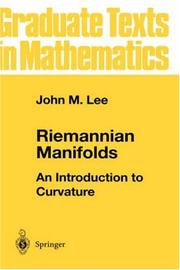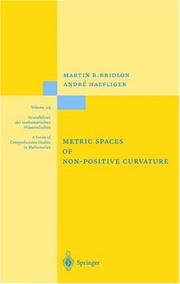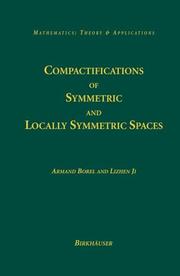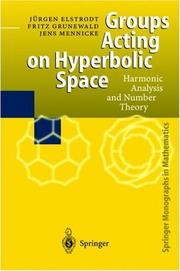| Listing 1 - 7 of 7 |
Sort by
|
Book
ISBN: 3540185720 0387185720 3540480188 9783540185727 Year: 1987 Volume: 1288 Publisher: Berlin Springer
Abstract | Keywords | Export | Availability | Bookmark
 Loading...
Loading...Choose an application
- Reference Manager
- EndNote
- RefWorks (Direct export to RefWorks)
Book
ISBN: 9789814291248 9814291242 Year: 2011 Publisher: Hackensack World scientific
Abstract | Keywords | Export | Availability | Bookmark
 Loading...
Loading...Choose an application
- Reference Manager
- EndNote
- RefWorks (Direct export to RefWorks)

ISBN: 038798271X 0387983228 0387227261 1280010142 9786610010141 9780387983226 Year: 1997 Volume: 176 Publisher: Berlin ; Heidelberg ; New York, NY [etc.] : Springer-Verlag,
Abstract | Keywords | Export | Availability | Bookmark
 Loading...
Loading...Choose an application
- Reference Manager
- EndNote
- RefWorks (Direct export to RefWorks)
This book is designed as a textbook for a one-quarter or one-semester graduate course on Riemannian geometry, for students who are familiar with topological and differentiable manifolds. It focuses on developing an intimate acquaintance with the geometric meaning of curvature. In so doing, it introduces and demonstrates the uses of all the main technical tools needed for a careful study of Riemannian manifolds. The author has selected a set of topics that can reasonably be covered in ten to fifteen weeks, instead of making any attempt to provide an encyclopedic treatment of the subject. The book begins with a careful treatment of the machinery of metrics, connections, and geodesics,without which one cannot claim to be doing Riemannian geometry. It then introduces the Riemann curvature tensor, and quickly moves on to submanifold theory in order to give the curvature tensor a concrete quantitative interpretation. From then on, all efforts are bent toward proving the four most fundamental theorems relating curvature and topology: the Gauss–Bonnet theorem (expressing the total curvature of a surface in term so fits topological type), the Cartan–Hadamard theorem (restricting the topology of manifolds of nonpositive curvature), Bonnet’s theorem (giving analogous restrictions on manifolds of strictly positive curvature), and a special case of the Cartan–Ambrose–Hicks theorem (characterizing manifolds of constant curvature). Many other results and techniques might reasonably claim a place in an introductory Riemannian geometry course, but could not be included due to time constraints.
Riemannian manifolds --- Riemann, Variétés de --- Mathematics --- Global differential geometry --- Riemannian manifolds. --- Geometry --- Physical Sciences & Mathematics --- 514.764.2 --- Riemannian and pseudo-Riemannian spaces --- 514.764.2 Riemannian and pseudo-Riemannian spaces --- Riemann, Variétés de --- EPUB-LIV-FT SPRINGER-B --- Mathematics. --- Differential geometry. --- Differential Geometry. --- Manifolds, Riemannian --- Riemannian space --- Space, Riemannian --- Geometry, Differential --- Manifolds (Mathematics) --- Global differential geometry. --- Differential geometry
Book
ISBN: 3110086735 9783110086737 Year: 1982 Volume: 1 Publisher: Berlin de Gruyter
Abstract | Keywords | Export | Availability | Bookmark
 Loading...
Loading...Choose an application
- Reference Manager
- EndNote
- RefWorks (Direct export to RefWorks)
Geometry, Riemannian --- 514.764.21 --- 514.7 --- Riemann geometry --- Riemannian geometry --- Generalized spaces --- Geometry, Non-Euclidean --- Semi-Riemannian geometry --- General theory of Riemannian and pseudo-Riemannian spaces --- Differential geometry. Algebraic and analytic methods in geometry --- 514.7 Differential geometry. Algebraic and analytic methods in geometry --- 514.764.21 General theory of Riemannian and pseudo-Riemannian spaces

ISSN: 00727830 ISBN: 3540643249 9783540643241 3642083994 3662124947 9783642083990 Year: 1999 Volume: 319 Publisher: Berlin Springer
Abstract | Keywords | Export | Availability | Bookmark
 Loading...
Loading...Choose an application
- Reference Manager
- EndNote
- RefWorks (Direct export to RefWorks)
The purpose of this book is to describe the global properties of complete simply connected spaces that are non-positively curved in the sense of A. D. Alexandrov and to examine the structure of groups that act properly on such spaces by isometries. Thus the central objects of study are metric spaces in which every pair of points can be joined by an arc isometric to a compact interval of the real line and in which every triangle satisfies the CAT(O) inequality. This inequality encapsulates the concept of non-positive curvature in Riemannian geometry and allows one to reflect the same concept faithfully in a much wider setting - that of geodesic metric spaces. Because the CAT(O) condition captures the essence of non-positive curvature so well, spaces that satisfy this condition display many of the elegant features inherent in the geometry of non-positively curved manifolds. There is therefore a great deal to be said about the global structure of CAT(O) spaces, and also about the structure of groups that act on them by isometries - such is the theme of this book. 1 The origins of our study lie in the fundamental work of A. D. Alexandrov .
Espaces métriques --- Geometry [Differential ] --- Géométrie différentielle --- Meetkunde [Differentiaal] --- Metric spaces --- Ruimten [Metrische ] --- Geometry, Differential --- 514.764.2 --- Spaces, Metric --- Generalized spaces --- Set theory --- Topology --- Differential geometry --- Riemannian and pseudo-Riemannian spaces --- Geometry, Differential. --- Metric spaces. --- 514.764.2 Riemannian and pseudo-Riemannian spaces --- Geometric group theory --- Groupes, Théorie géométrique des --- Topology. --- Manifolds (Mathematics). --- Complex manifolds. --- Group theory. --- Manifolds and Cell Complexes (incl. Diff.Topology). --- Group Theory and Generalizations. --- Groups, Theory of --- Substitutions (Mathematics) --- Algebra --- Analytic spaces --- Manifolds (Mathematics) --- Analysis situs --- Position analysis --- Rubber-sheet geometry --- Geometry --- Polyhedra --- Algebras, Linear --- Groupes, Théorie géométrique des. --- Géometrie différentielle globale --- Géometrie différentielle globale --- Topologie differentielle --- Groupes, Théorie géométrique des.

ISBN: 0817632476 9780817632472 0817644660 9786610624058 1280624051 Year: 2006 Publisher: Boston Birkhäuser
Abstract | Keywords | Export | Availability | Bookmark
 Loading...
Loading...Choose an application
- Reference Manager
- EndNote
- RefWorks (Direct export to RefWorks)
Noncompact symmetric and locally symmetric spaces naturally appear in many mathematical theories, including analysis (representation theory, nonabelian harmonic analysis), number theory (automorphic forms), algebraic geometry (modulae) and algebraic topology (cohomology of discrete groups). In most applications it is necessary to form an appropriate compactification of the space. The literature dealing with such compactifications is vast. The main purpose of this book is to introduce uniform constructions of most of the known compactifications with emphasis on their geometric and topological structures. The book is divided into three parts. Part I studies compactifications of Riemannian symmetric spaces and their arithmetic quotients. Part II is a study of compact smooth manifolds. Part III studies the compactification of locally symmetric spaces. Familiarity with the theory of semisimple Lie groups is assumed, as is familiarity with algebraic groups defined over the rational numbers in later parts of the book, although most of the pertinent material is recalled as presented. Otherwise, the book is a self-contained reference aimed at graduate students and research mathematicians interested in the applications of Lie theory and representation theory to diverse fields of mathematics.
Symmetric spaces --- Espaces symétriques --- EPUB-LIV-FT LIVMATHE SPRINGER-B --- Topological Groups --- Compactifications. --- Compactifications --- 514.764.2 --- Riemannian and pseudo-Riemannian spaces --- 514.764.2 Riemannian and pseudo-Riemannian spaces --- Spaces, Symmetric --- Mathematics. --- Algebraic geometry. --- Topological groups. --- Lie groups. --- Applied mathematics. --- Engineering mathematics. --- Geometry. --- Number theory. --- Algebraic topology. --- Topological Groups, Lie Groups. --- Algebraic Topology. --- Number Theory. --- Algebraic Geometry. --- Applications of Mathematics. --- Geometry, Differential --- Topology --- Symmetric spaces. --- Algebraic topology --- Geometry --- Geometry, Algebraic --- Mathematics --- Number Theory --- Topological Groups. --- Geometry, algebraic. --- Math --- Science --- Algebraic geometry --- Euclid's Elements --- Number study --- Numbers, Theory of --- Algebra --- Groups, Topological --- Continuous groups --- Engineering --- Engineering analysis --- Mathematical analysis --- Groups, Lie --- Lie algebras --- Topological groups

ISBN: 3540627456 3642083021 3662036266 Year: 1997 Publisher: Berlin Springer
Abstract | Keywords | Export | Availability | Bookmark
 Loading...
Loading...Choose an application
- Reference Manager
- EndNote
- RefWorks (Direct export to RefWorks)
This book is concerned with discontinuous groups of motions of the unique connected and simply connected Riemannian 3-manifold of constant curva ture -1, which is traditionally called hyperbolic 3-space. This space is the 3-dimensional instance of an analogous Riemannian manifold which exists uniquely in every dimension n :::: 2. The hyperbolic spaces appeared first in the work of Lobachevski in the first half of the 19th century. Very early in the last century the group of isometries of these spaces was studied by Steiner, when he looked at the group generated by the inversions in spheres. The ge ometries underlying the hyperbolic spaces were of fundamental importance since Lobachevski, Bolyai and Gauß had observed that they do not satisfy the axiom of parallels. Already in the classical works several concrete coordinate models of hy perbolic 3-space have appeared. They make explicit computations possible and also give identifications of the full group of motions or isometries with well-known matrix groups. One such model, due to H. Poincare, is the upper 3 half-space IH in JR . The group of isometries is then identified with an exten sion of index 2 of the group PSL(2,.
Automorphic forms. --- Functions, Zeta. --- Selberg trace formula. --- Spectral theory (Mathematics). --- 514.764.22 --- Selberg trace formula --- Trace formulas --- Special types of Riemannian space. Reducible, recurrent, symmetric Riemannian and pseudo-Riemannian spaces. Einstein spaces --- 514.764.22 Special types of Riemannian space. Reducible, recurrent, symmetric Riemannian and pseudo-Riemannian spaces. Einstein spaces --- Automorphic forms --- Functions, Zeta --- Spectral theory (Mathematics) --- Functional analysis --- Hilbert space --- Measure theory --- Transformations (Mathematics) --- Number theory --- Riemann surfaces --- Zeta functions --- Automorphic functions --- Forms (Mathematics) --- Group theory. --- Special functions. --- Number theory. --- Global analysis (Mathematics). --- Manifolds (Mathematics). --- Group Theory and Generalizations. --- Special Functions. --- Number Theory. --- Global Analysis and Analysis on Manifolds. --- Geometry, Differential --- Topology --- Analysis, Global (Mathematics) --- Differential topology --- Functions of complex variables --- Geometry, Algebraic --- Number study --- Numbers, Theory of --- Algebra --- Special functions --- Mathematical analysis --- Groups, Theory of --- Substitutions (Mathematics)
| Listing 1 - 7 of 7 |
Sort by
|

 Search
Search Feedback
Feedback About UniCat
About UniCat  Help
Help News
News